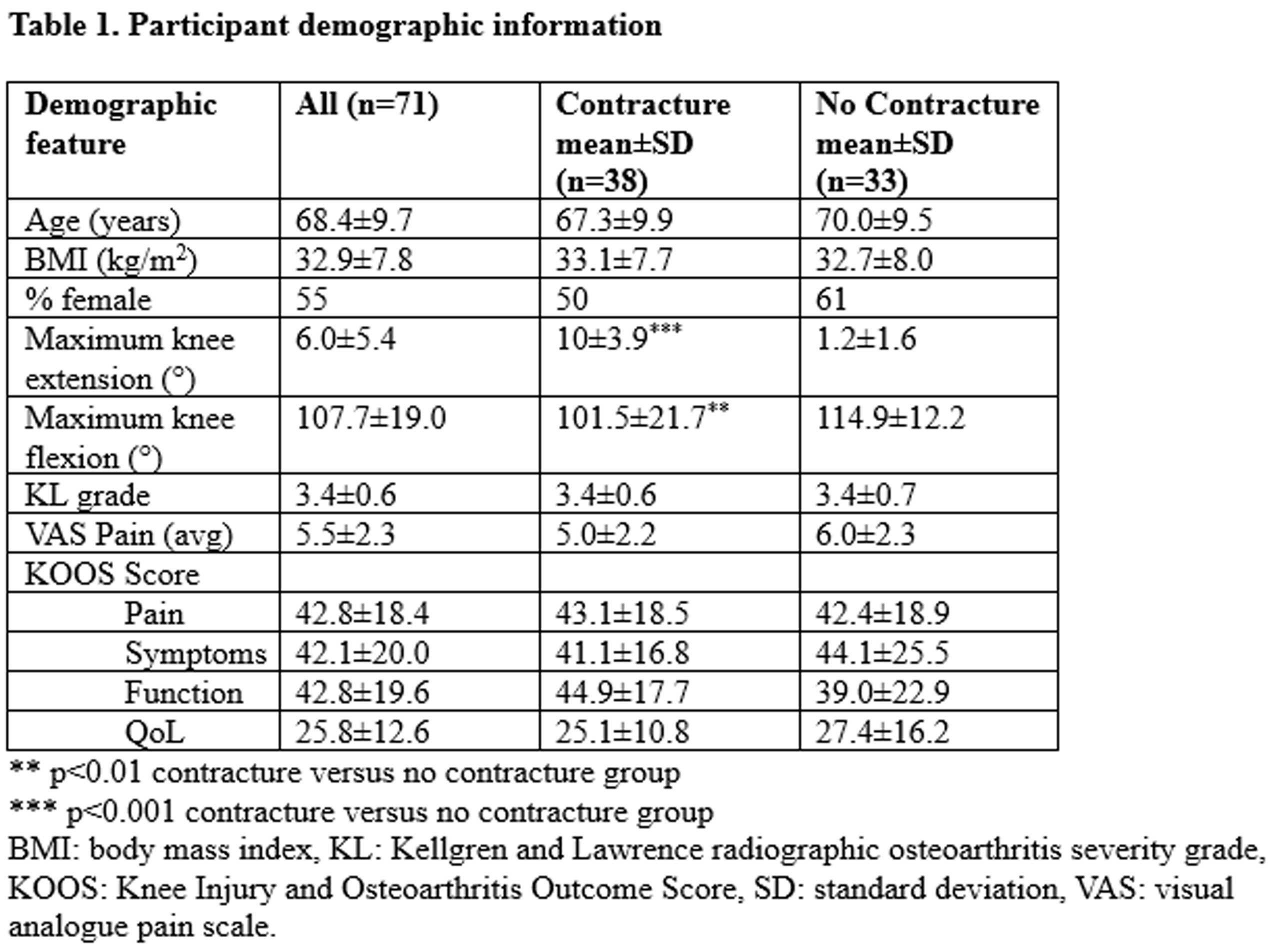Session Information
Date: Saturday, November 16, 2024
Title: Abstracts: Osteoarthritis – Novel Insights from Observational Studies
Session Type: Abstract Session
Session Time: 3:00PM-4:30PM
Background/Purpose: Osteoarthritis is a common and debilitating condition without cure. Increased OA severity is associated with lost range of motion (ROM) in the affected joint. Lost ROM may be due to increased fibroblast activity in the joint capsule, leading to fibrous tissue formation1, 2. Fibroblasts are in turn derived from mesenchymal stromal cells (MSCs). To date, a description of capsular MSCs and their association with clinical outcomes is lacking. In this study, we used the Ottawa Knee OA (OKOA) database to test the hypotheses that people with knee OA having a flexion contracture (FC) had increased fibrous tissue and MSC fibrous activity in the posterior capsule. We also analyzed associations between clinically-relevant OA outcomes and histological composition as well as MSC enumeration and differentiation capacity.
Methods: 71 OKOA participants were included (Table 1). Clinical outcomes included maximum knee extension, flexion, radiographic Kellgren and Lawrence (KL) grade, visual analogue (VAS) pain, and Knee Injury and Osteoarthritis Outcome Score (KOOS) scores. Lab-based outcomes included histologic determination of posterior and anterior tissue composition proportions (fibrous, adipose, synovium, other), MSC enumeration (colony-forming unit assay, flow cytometry) and MSC differentiation capacity (fibrogenic, adipogenic, chondrogenic, osteogenic). Associations were first tested with bivariate correlation. Associations with p< 0.10 were further tested using a linear model with generalized estimating equations (GEE), correcting for age, sex, BMI.
Results: No significant differences between FC and no FC groups we discovered. In the posterior capsule, GEE analysis showed associations between the range of knee flexion and MSC adipogenic capacity, MSC osteogenic capacity, KL grade and % other tissue (mainly neurovascular tissue), VAS pain and % fibrous tissue (Table 2). In the anterior capsule, GEE analysis showed associations between the range of knee extension and flow cytometry MSC enumeration, knee flexion, flow cytometry MSC enumeration, KL grade, MSC fibrogenic capacity, MSC chondrogenic capacity and KOOS quality of life (Table 2).
Conclusion: Joint capsule histology and MSCs were associated with important clinical outcomes of knee OA including knee extension, flexion, KL grade, VAS pain and QoL. These findings suggest that the entire joint capsule, not only the synovium may play important roles in OA-related morbidity and progression and could represent an underappreciated target for OA treatment.
To cite this abstract in AMA style:
Campbell T, Feibel R, Dilworth J, Laneuville O, Trudel G. Stem Cell Function and Capsule Tissue Composition Are Associated with Symptoms, Joint Range of Motion and Radiographic Severity in People with Knee Osteoarthritis [abstract]. Arthritis Rheumatol. 2024; 76 (suppl 9). https://acrabstracts.org/abstract/stem-cell-function-and-capsule-tissue-composition-are-associated-with-symptoms-joint-range-of-motion-and-radiographic-severity-in-people-with-knee-osteoarthritis/. Accessed .« Back to ACR Convergence 2024
ACR Meeting Abstracts - https://acrabstracts.org/abstract/stem-cell-function-and-capsule-tissue-composition-are-associated-with-symptoms-joint-range-of-motion-and-radiographic-severity-in-people-with-knee-osteoarthritis/


